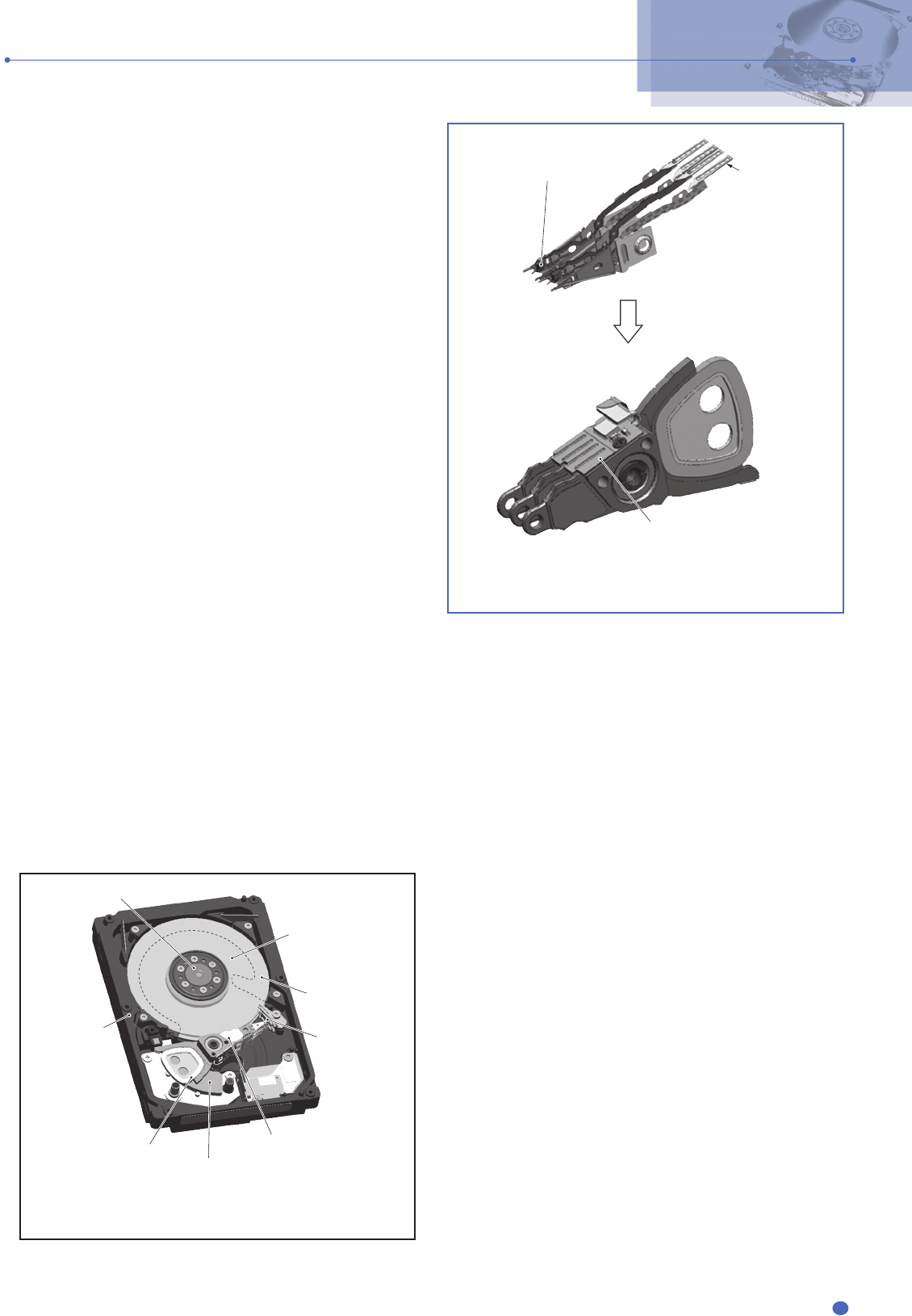
TOSHIBA
Storage Products for ICT Society
41
Feature Articles
Feature Articles
3. Hardware Technologies
Figure 1 shows the drive’s internal structure. The
mechanical dimensions are compatible with SFF-
8201/8223, the industry standard for 2.5-inch HDDs.
Although drives for mobile PCs are thin as 9.5 mm thick,
this drive is 15 mm thick to have a highly rigid base plate
and top cover for high-speed rotation. Through computer
aided engineering (CAE) using finite element method (FEM)
analysis, we have optimized its mechanical architecture
to enable high performance, low acoustic noise, and low
power consumption.
We use fluid dynamic bearings (FDB) motor for their low
vibration and acoustic noise properties. Bearings are
the most critical mechanical component; they decisively
influence HDD operating life and reliability. For this reason,
the bearing design we use is the same as field-proven
conventional bearings. We used glass substrate disks with
an outer diameter of 57 mm and a plate thickness of 1.27
mm. An air stabilizer is placed between magnetic disks as
indicated by the dotted line in Figure 1. This air stabilizer,
which covers 3/4 of the disk periphery, is able to reduce
the disk vibration and windage generated by such high-
speed disk rotation. Lower vibration and windage is able
to reduce positioning errors (disturbance force) during the
positioning control of the head over the target track.
Within the disk enclosure of MK3001GRRB (with a
storage capacity of 300 GB), four heads are mounted on a
carriage. The carriage is in turn mounted on a base via a
pair of small-sized ball bearings. The carriage is actuated
by a voice coil motor (VCM), which includes a flat coil and
magnets.
To achieve a storage capacity of 300 GB, the heads
include a newly developed head disk interface (HDI) sensor
which responds to subtle heat fluctuations between
the head and disk, between which there is a very small
clearance. In recent years, HDDs have included heaters
which are embedded in the heads’ read/write elements.
By controlling heater power, the clearances between read/
write elements and magnetic disk surfaces can be finely
controlled, thereby achieving a high recording density.
The HDI sensor is a functional element for controlling
clearance accurately. When mounting the HDI sensor, as
each head has a total of eight terminals—the existing six
terminals for read, write, and heater plus two additional
terminals—these terminals must be connected to the
flexible printed circuit (FPC) with high precision. Figure
2 shows a schematic drawing in which heads with HDI
sensors are attached to the FPC, which is in turn mounted
on the carriage.
To enable high speed seeking (average = 2.7 ms), it is
important to design a high-performance actuator with
both a powerful VCM and a lightweight and vibration-
proof carriage. When designing the VCM, we ensured high
efficiency by optimizing shapes and materials through
magnetic field analyses. For the carriage design, we
conducted a large-scale FEM analysis (Figure 3) for the
entire piece of hardware and optimized the shapes and
structures of the mechanical components to prevent
undesirable vibrations and improve the damping of
vibrations, particularly those caused by large VCM forces
during the acceleration or deceleration of the carriage.
8 Terminals
Head with HDI Sensor
FPC
Figure 2 Connection of head-disk interface (HDI) sensor to flexible printed circuit
(FPC)—High-density connecting technology was used to implement the HDI sensors,
which are functional elements to increase HDD capacity.
FDB Motor
Magnetic Disks
Air stabilizer
Heads
Carriage
Base Plate
Flat coil
Magnet
Figure 1 Internal structure of MK3001GRRB—High reliability, high performance, low
acoustic noise, and low power consumption were achieved by optimizing the design of
the HDD’s mechanical components.
